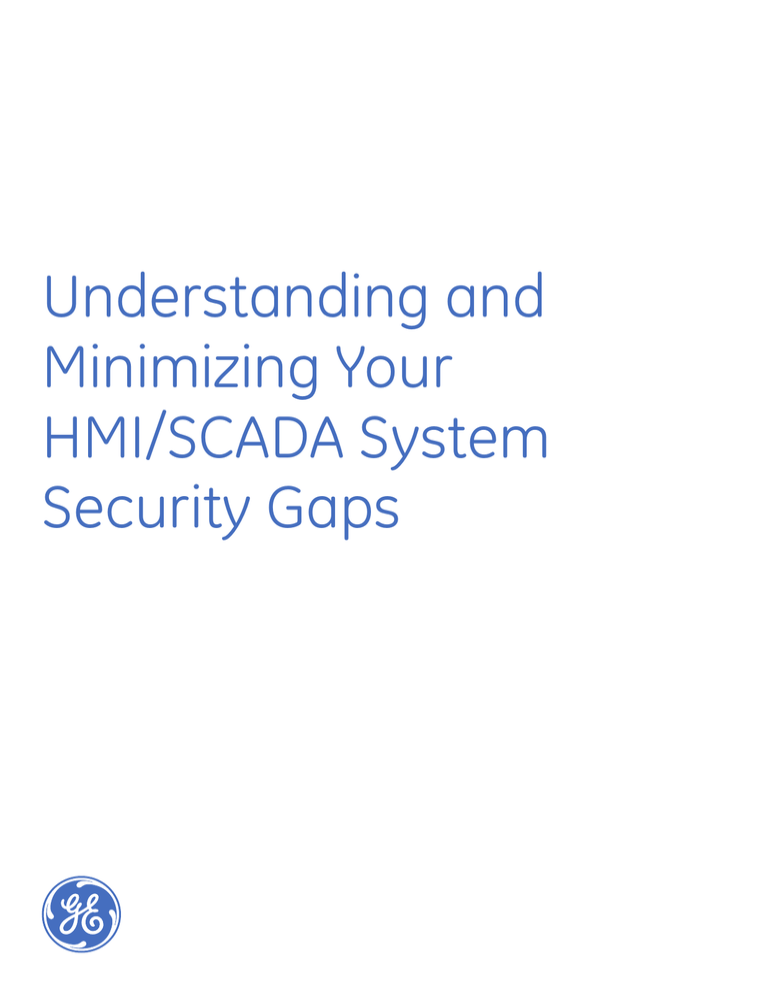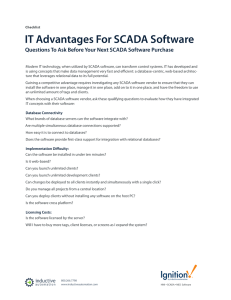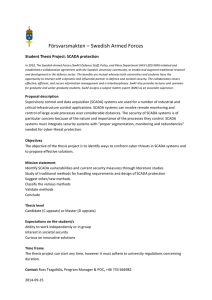
Understanding and
Minimizing Your
HMI/SCADA System
Security Gaps
Understanding and Minimizing Your HMI/SCADA System Security Gaps
Being at the heart of an operation’s data visualization, control
and reporting for operational improvements, HMI/SCADA systems have received a great deal of attention, especially due to
various cyber threats and other media-fueled vulnerabilities.
The focus on HMI/SCADA security has grown exponentially in
the last decade, and as a result, users of HMI/SCADA systems
across the globe are increasingly taking steps to protect this
key element of their operations.
The HMI/SCADA market has been evolving over the last 20
years with functionality, scalability and interoperability at
the forefront. For example, HMI/SCADA software has evolved
from being a programming package that enables quick
development of an application to visualize data within a programmable logic controller (PLC) to being a development suite
of products that delivers powerful 3-D visualizations, intelligent
control capabilities, data recording functions, and networkability. With HMI/SCADA systems advancing technologically
and implementations becoming increasingly complex, some
industry standards have emerged with the goal of improving
security. However, part of the challenge is knowing where to
start in securing the entire system.
The purpose of this paper is to explain where vulnerabilities
within a HMI/SCADA system may lie, describe how the inherent
security of system designs minimize some risks, outline some
proactive steps businesses can take, and highlight several
software capabilities that companies can leverage to further
enhance their security.
SCADA security in context
The International Society of Automation (ISA) production model
demonstrates the layered structure of a typical operation, and
shows that HMI/SCADA security is only one part of an effective
cyber-security strategy. These layers of automated solution
suites share data, and wherever data is shared between devices,
there is a possibility for unauthorized access and manipulation
of that data. This white paper concentrates on the HMI/SCADA
layer, but unless other potential weaknesses at other levels are
covered, the operation as a whole remains vulnerable.
ERP
MES
SCADA/HMI
PLC/DCS
Sensor and Actuator
Component vulnerabilities within an HMI/SCADA system
To minimize existing security gaps, companies need to first
understand where potential vulnerabilities typically lie within
the system. Powerful software features, along with the advancements in automation hardware and industrial communications,
have made control systems multi-layered, complex and susceptible to threats. An HMI/SCADA system’s level of security
is best understood if broken down into two major elements:
Communication and Software Technology.
Communication
Communication advancements have made large-scale
HMI/SCADA system implementations successful for many industry applications. There are two levels of communication that
exist within the system—information technology (IT) and the
field, which have notable security level differences.
2
IT – Components of an HMI/SCADA system are modular, not
only to allow for easy troubleshooting but also to distribute the
computing load and eliminate a single point of failure. It is not
uncommon to have multiple thick, thin, web and mobile runtime
clients connected to the main HMI/SCADA server hub over an
internal Ethernet-based network; however in some cases, systems may use external leased lines, modems, wireless, cellular,
or satellite technologies as well.
The main HMI/SCADA server hub also consists of multiple networked servers to distribute the load, ensure uptime, and store
the mass amount of data. With these components all networked
in some way, they use standardized common protocols to transfer data—all of which are largely unencrypted, requiring weak or
no authentication.
Field – HMI/SCADA implementations frequently consist of a
number of widely dispersed remote sites with a control or
data gathering function, all connected to a central control and
monitoring point. Data has to be passed between the control
room and the remote terminal units (RTUs) over a network
(which may be fiber optic, telephone or wireless), and the protocols for passing this data have frequently been developed with
an emphasis on reliability and ease of implementation rather
than security.
Modern computing facilities have made secure practical encryption almost impossible to defend against a determined hacker,
so communications between devices need to employ several
layers of defense with the primary aim to make access to the
data difficult, and detect if the data has been compromised.
Software technology
Software over the years has largely become feature-bloated as
companies keep adding new capabilities while maintaining all
of the existing ones, increasing the complexity of software
security. There are two separate but dependent software
technologies in the system, the HMI/SCADA software and the
Platform Operating System, which have distinct differences
when it comes to security.
HMI/SCADA Software - Most HMI/SCADA software installations
have either external network connections or direct Internetbased connectivity to perform remote maintenance functions
and/or connect up to enterprise systems. While these types of
connections help companies reduce labor costs and increase
the efficiency of their field technicians, it is a key entry point for
anyone attempting to access with a malicious intent.
Platform Operating System – Operating systems that employ
elements of consumer or “open” source operating systems
such as Windows Server, Linux and Unix variants are increasingly popular since they help reduce costs. This trend toward
open technologies has made proprietary custom, closed, highly
secure systems a direction of the past, but it increases the risks.
Also, due to the fact that HMI/SCADA systems are complex and
contain multiple layers of technology, even a simple system
patch is a major undertaking that requires planning, funding
and time. The risk elements are also substantial because many
systems now rely solely on their HMI/SCADA system for visualization, data recording and some control elements. And to this
point, some companies hold back on patches, service packs and
upgrades, while others choose not to apply any new patches,
employing a “it works, don’t touch it” policy. Furthermore, software patches have generally been developed to cover for a
security breach that has already occurred.
Some would say that even if companies could keep their platforms current, with the fast pace of consumer-based operating
systems and large number of system exploits, platform operating systems are the single largest security risk in the system.
3
Understanding and Minimizing Your HMI/SCADA System Security Gaps
The inherent security of system designs minimizes some risks
The good news is that some vulnerability is minimized by the
nature of system design and HMI/SCADA software design,
whereby the fundamental principles and canons of engineering
mandate safe and reliable systems. This ensures a basic level of
security to protect against an intruder.
Engineers design systems with intentionally broken automated
chains—meaning in some cases functions require physical
confirmation prior to the software performing commands and
in other cases, the SCADA software only does a portion of the
command, requiring one or many additional manual steps to
execute the function. Inherent system security is best surmised
at the software and hardware levels.
• Software: With many viewing HMI/SCADA software as a visualization tool that provides a means for dynamic operator
input and visualization as a flexible information terminal, the
reality is that HMI/SCADA software capabilities are much more
exhaustive. When elements are added such as control and
logic capabilities, system engineers must examine the risk
from a potential failure standpoint and the extent of control
that is allowed without being in line of sight of the area being
controlled.
Software is also developed from the operator’s perspective
and uses company guidelines throughout the application
to ensure the operator is controlling with intent. While this
doesn’t necessarily bring additional security from external intruders, it does provide enhanced protection against
mistakes. For example, the “select before operate” design
4
Inherent Security Examples
1. Manufacturing and Part Movement
a.An HMI/SCADA system is programmed to command an automated gantry to move manually.
b.To move the automated gantry, the HMI/SCADA
“soft” button must be engaged as well as separate
manual pushbuttons.
c.The automated gantry system is also interlocked
with photoelectric sensors, and will not move if it
detects any object within its operating area.
d.Additionally, there are two physical mats on the
plant floor outside the operating area within line
of sight of the gantry on the plant floor—one in
front of the HMI/SCADA terminal and one in front of
the manual pushbutton station. These mats have
built-in sensors to ensure that someone is physical
present prior to operating.
e.All conditions must be true for the automated
gantry systems’ manual functions to be powered
up and engaged. This type of system design is
largely for the safety of the workforce, but also
ensures that a hacker cannot independently
operate this function if he has control of the HMI/
SCADA system.
philosophy is typically used in HMI/SCADA applications, which
requires the operator to select an item on the screen, pull up
the controlling elements, operate the item, and finally confirm
to send the command. While this may seem like a simple ideology or a drawn out process, this intentional design ensures
that an operator’s actions are deliberate as opposed to a
hasty reaction to an urgent situation.
• Hardware: At this level, design engineers employ many techniques to ensure safe control, either physically or by the HMI/
SCADA software. Thousands of individual devices and RTUs
can exist in a system and are typically implemented with
an area-based manual or automatic control selection; field
technicians use manual control to perform maintenance or to
address a software failure—locking out the software control
and establishing local control.
Additionally, when engineers design this level of the system,
many hardware-based fail-safes are built in the design such
as fusing or hardwire interlock logic to examine the local situation, so when components are commanded by the HMI/
SCADA software, there is a hardware level of checks to ensure
it can be executed. This protects the system from unsafe or
even incorrect software control. Furthermore, many critical
applications use triple and quad redundant logic controllers to
ensure continuous operations.
Taking into account the general design rule that system engineers apply for all levels of a system can be surmised by “if a
single point of failure exists, protect it or provide secondary
means.” Therefore, design philosophies typically drive a holistically safe and secure environment, which can severely impede
an intruder’s ability at the HMI/SCADA level to impact the
entire system.
2. Water Treatment and Chemical Control
a.An HMI/SCADA system in a water treatment plant is
the main control point for chemicals
being added to the water.
b.One of the key chemicals controlled by the HMI/
SCADA system is chlorine. Excessive amounts of
chlorine could be hazardous to public health, and
conversely too little can also put people in danger,
so engineers have designed a level of safety into the
automation system.
c.While the HMI/SCADA system controls the main
chlorine values, downstream chlorine meters continuously measure the concentration level and have
the ability to cut off the chlorine addition in the
event of abnormal levels.
d.The metering control elements are isolated from
the HMI/SCADA control with the only interaction
between the systems being a one-way alarming
connection to enunciate in the event of abnormal
levels of chlorine.
e.Additionally, water treatment facilities are mandated to frequently test the chemical makeup of
the outgoing water. The system’s operators analyze the test results daily and have the ability to
cut off and bypass the chemical systems based on
the test results.
f.With this multi-tiered automation and manual ability designed into the system, the system as a whole
has an inherent level of security against rogue
remote control and malicious attacks.
5
Understanding and Minimizing Your HMI/SCADA System Security Gaps
Be proactive: Enhance your security with software capabilities
However, even the safest system design and industry standards cannot secure a system 100%, and therefore, companies
should not rely on them wholly to protect their systems.
Instead, they should take a proactive approach to enhancing
security, and a good starting point is knowing what technologies are available to help them best meet their needs.
Selecting a trusted solution provider with deep expertise, experience and advanced technologies is also critical. Off-the-shelf
HMI/SCADA solutions such as GE software have successfully
helped companies minimize their security gaps with a broad
range of security-based software technologies, including:
• Biometrics – When bio-security elements are integrated to
the system, customers can program their system to require
finger scans to perform specific functions such as switching
on and off the grid’s main switchgears, which ensures that the
appropriate person be physically present to execute the order.
This type of integration eliminates the possibility of a hacker
performing the same operation virtually—reducing the overall
potential impact and enhancing the overall system security.
• Electronic Signature – Many view this option as a simple
reporting tool, however the features are much more comprehensive. For example, it can introduce authentication
potential at the command level to verify the user performing
the operation with a username and password as well as a
separate authentication, typically a manager, for verification.
The information is then stored in a system audit trail that
can be recalled in the future; some customers also choose to
integrate this feature with biometrics to eliminate the use of a
single, widely known username and password.
6
Considerations to critically examine
your system
1. Examine
your field assets, particularly older, remote
components
• How does the SCADA communicate with them?
Can this be secured?
• Is the control network adequately separated from
other networks?
• Where are the points of entry/failure? Are there
redundant options?
2. Examine your IT assets
• Are the services/software running on an asset the
minimum needed to maintain functionality?
• How secure is that software and does the software
employ passwords, biometrics or retina protection?
• Do you have easy access to the operating system
and SCADA system patches? Is this automatic?
3. Examine your change management software policy
• What is the policy for implementing an operating system and SCADA patches – does it cover all assets?
• Are all assets protected (covered by firewalls and
anti-virus software)?
• How easy is it to manage user accounts across all
layers of software – is there an integrated system
that includes the operating system and software
products or does each product have separate user
accounts and passwords?
• Authorized Connections & Client/Server Data Encryption –
Many off-the-shelf HMI/SCADA software products now have
built-in features that limit the allowable client connections to
known computers and use integrated data encryption for client communications. This protective capability eliminates the
possibility of a hacker simply loading the HMI/SCADA client
and connecting over the network.
• DomainAuthentication–Toleveragecomplexalphanumeric
passwords at the HMI/SCADA level, some software packages
offer an add-on capability that introduces Windows® Domain
Authentication security integration. For example, GE features
an application add on that maps group memberships to its GE
iFix software roles and when integrated, the users and
subsequent passwords are managed at the IT level. This
allows for the HMI/SCADA application to leverage existing
group IT-level policies, which are typically very stringent and
can exceed industry requirements.
Funding in today’s business climate
Improving an overall system’s security can be a costly endeavor,
and companies must find the right balance between spend,
design and process to make their systems safe. This is especially
true as companies face increasing cost reductions mandated
in today’s challenging economic environment. In response,
off-the-shelf HMI/SCADA vendors have developed industry solution packs that include specifically tailored tools to help reduce
development and overall system costs.
Forexample,GE's iPower,Water,&OEMSolutions Packs
offers complete, pre-developed, HMI/SCADA drag-and-drop
elements, graphics, toolsets and configuration
4. Examine your access control
• Does your SCADA software allow anonymous client
connections?
• Is there a robust login policy with regular renewal of
passwords?
• Does each user have an appropriate limit to their
actions?
tools that significantly reduce both the initial and ongoing costs
associated with HMI/SCADA software. Companies can then reroute the resulting cost savings into additional security software
and hardware to augment the inherent safety of their systems—
reducing overall vulnerability.
The cost of implementing an HMI/SCADA security policy
should also be evaluated against the risk of a security
breach—in terms of reputation, liability and intellectual property.
Companies may discover a proactive approach actually reduces
overall costs by ensuring business continuity when compared to
the potential operational and financial loss that can occur due
the exposure of an unprotected system.
7
Understanding and Minimizing Your HMI/SCADA System Security Gaps
Conclusion
The vulnerabilities of HMI/SCADA systems pose a serious threat,
and the complexity of multi-layered technologies make it difficult to completely secure one’s operation. As discussed in this
paper, the inherent safe design of most HMI/SCADA systems
offers some protection, but they are by no means enough to
fully protect systems.
That’s why it’s important for companies to better understand
where vulnerabilities exist within their systems and to take a
proactive approach to address those susceptible areas. Offthe-shelf HMI/SCADA vendors offer software solutions with
security-based capabilities, which can help companies enhance
the protection of their critical infrastructure assets and reduce
costs for a sustainable competitive advantage.
About GE
GE (NYSE: GE) is the world’s Digital Industrial Company, transforming industry with
software-defined machines and solutions that are connected, responsive and
predictive. GE is organized around a global exchange of knowledge, the "GE Store,"
through which each business shares and accesses the same technology, markets,
structure and intellect. Each invention further fuels innovation and application across
our industrial sectors. With people, services, technology and scale, GE delivers better
outcomes for customers by speaking the language of industry. www.ge.com
Contact information
Americas: 1-855-YOUR1GE (1-855-968-7143)
gedigital@ge.com
www.ge.com/digital
©2015 General Electric. All rights reserved. *Trademark of
General Electric. All other brands or names are property of
their respective holders. Specifications are subject to
change without notice.
01.10 GFT-759A






